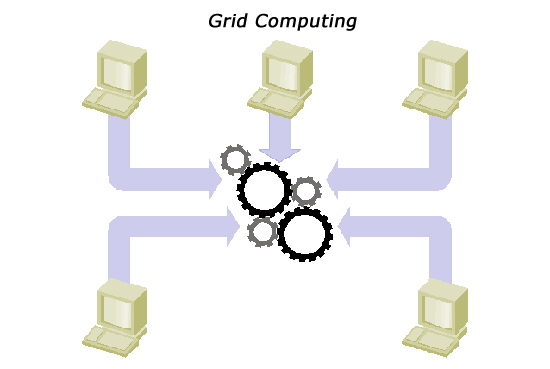 Grid technology allows organizations to use numerous computers to solve problems by sharing computing resources. The problems to be solved might involve data processing, network bandwidth, or data storage. The systems tied together by a grid might be in the same room, or distributed across the globe running on multiple hardware platforms having different operating systems and these systems can be owned by different organizations.
Grid technology allows organizations to use numerous computers to solve problems by sharing computing resources. The problems to be solved might involve data processing, network bandwidth, or data storage. The systems tied together by a grid might be in the same room, or distributed across the globe running on multiple hardware platforms having different operating systems and these systems can be owned by different organizations.
The basic idea of grid computing is to grant users one platform where user can undertake a particular task which requires large computing power. Grid computing requires the use of software that can divide and farm out pieces of a program to as many as several thousand computers.
Grid computing appears to be a promising trend for three reasons:
1. Its has the ability to make more cost-effective use of a given amount of computer resources.
2. It provides the way to solve problems that can’t be approached without an enormous amount of computing power.
3. It suggests that the resources of many computers can be co-operative to each other so that they are able to solve a common problem.
Grids provide the ability to perform computations on large data sets, by breaking them down into many smaller ones, or provide the ability to perform many more computations at once than would be possible on a single computer. Grid computing does require special software that is unique to the computing project for which the grid is being used.
The real and specific problem that underlies the Grid concept is coordinated resource sharing and problem solving in dynamic, multi-institutional virtual organization.
Grid computing is an evolving area of computing, where standards and technology are still being developed to enable this new technology.
Main Advantages of Grid Computing –
1. Lower Computing Costs
On a price to performance basis, the Grid platform delivers better output with less administration and budget than dedicated hardware solutions. Depending on the size of network, the price-for-performance ratio for computing power can improve drastically.
2. Faster Project Results
The extra power generated by the Grid platform can directly impact an organization’s ability to win in the marketplace by shortening product development cycles and accelerating research and development processes.
3. Better Product Results
Increased, affordable computing power means not having to ignore promising avenues or solutions because of a limited budget or schedule. The power created by the Grid platform can help to ensure a higher quality product by allowing rigorous testing ,so that the final output is more robust.
There are six major components which grid computing should consist of –
1. Security
2. User interface
3. Workload management
4. Scheduler
5. Data management
6. Resource management
The above image shows how Grid Computing functions
Security – Computers on a grid are networked and running applications that are processed can have extremely valuable data, so the security component of grid computing is of great concern. This component includes elements such as encryption, authentication, and authorization.
User interface – Accessing information on the grid is also quite important, and the user
interface component handles this task for the user.
Workload management – Applications that a user wants to run on a grid must be aware of the resources that are available, this is where a workload management comes in to play so that user discover the available resources and their status.
Scheduler-A scheduler is needed to locate the computers on which to run an application, and to assign the jobs required. This can be as simple as taking the next available resource, but often this task involves prioritizing job queues, managing the load, finding workarounds when encountering reserved resources, and monitoring progress.
Data management-If an application is running on a system that doesn’t hold the data then the resources which are involved in that particular task will go waste so its this data management which ensures the proper rolling of the data throughout the task.
Resource management – To handle such core tasks as launching tasks with specific resources, monitoring the status of those tasks, and retrieving results is what resource management facility is necessary for.
To build a grid, you need tools. Grid tools fall into these general categories:
1. Infrastructure components include file systems, schedulers and resource managers, messaging systems, security applications, certificate authorities, and file-transfer mechanisms, such as GridFTP.
2. Systems on a grid must be able to discover what services are available to them. They must be able to define (and monitor) a grid’s topology in order to share and collaborate. To do this, there are grid directory services and implementations are based on existing models such as LDAP (Lightweight Directory Access Protocol, is an Internet protocol that email and other programs use to look up information from a server), DNS (Domain Name System, is used mostly to translate between domain names and IP addresses) and network management protocols.
3. One of the main benefits of a grid is the ability to maximize efficiency. This is done through schedulers and load balancers. Schedulers ensure that jobs are completed in some order (such as priority, deadline, urgency, etc.), and load balancers distribute tasks and data management across systems to decrease the chance of overloading on to a particular system.
-Image Courtsey http://www.praxagora.com
